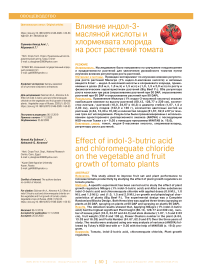Effect of indol-3-butric acid and chloromequate chloride on the vegetable and fruit growth of tomato plants
Автор: Suliman Ahmad Aly, Abramov Aleksandr G.
Журнал: Овощи России @vegetables
Рубрика: Овощеводство
Статья в выпуске: 1 (51), 2020 года.
Бесплатный доступ
Relevance. This study aimed to improve fruit set and plant performance to increase tomato productivity by studying the effect of plant growth regulators on tomato plants. Methods. A specific experiment has been carried out to study the effect of plant growth regulators Milagro (1% indol-3-butric acid) and Atlet active substances indol-3-butric acid and chloromequate chloride with applied doses (0.6 M/L, 1.0 M/L and 1.5 M/L) and (1.0, 1.5 and 2.0 M/L) on growth and physiological characteristics of plants (Big Beef F1). The experimental design was a Complete Randomized Blocks Design. Both Hemo bles was applied three times (spraying on plants at 30 DAP, spraying on plants at 60 DAP and spraying on plants 90 DAP). Results. The obtained results showed that, Applying Milagro (1% indol-3-butric acid) had the highest significant Plant height (80.13, 128.77 and 239 cm), number of leaves/plant (18.0, 34.67 and 44.3) and stem diameter (1.07, 1.5 and 2.03 cm), fruit weight (122.0 and 136 g), Flower Clusters number in the plant (4.64, 13.33 and 16.33) and Fruits Number (61.67, 62.0 and 67) Over the three years of study. The results were analyzed using one-way analysis of variance (ANOVA) followed by Tukey’s HSD test with а = 0.05 with the help of MINITAB (v. 19.0) program.
Tomato, indol-3-butric acid, chloromequate chloride, plant growth regulators
Короткий адрес: https://sciup.org/140248047
IDR: 140248047 | УДК: 631.811.98:635.64-02 | DOI: 10.18619/2072-9146-2020-1-50-53
Текст научной статьи Effect of indol-3-butric acid and chloromequate chloride on the vegetable and fruit growth of tomato plants
Tomato ( Lycopersicon esculentum Mill.) belongs to the family Solanaceae . Tomato is the most important vegetable crop in both open field and greenhouses (Kaloo, 1986). In view of the rapid increase in population growth and the increase in consumption of foodstuffs, including the tomato crop, scientific studies have begun on the methods available to increase production, including the study of the influence of growth organizations agricultural production, farmers often apply some chemical substances which have similar structure and activity with endogenous plant hormone called exogenous Plant Growth Regulators (PGRs); as a cheap alternative to enhance plant growth and increase productivity [Chin J. A., 2015]. Application of plant growth regulators has been found very effective in improving quantity and quality of many crops [Sandeep K. S. et al., 2013]. Plant Growth Regulators (PGRs) have wide category of compounds that can enhance, inhibit or change plant morphological or physiological processes at very low concentrations. Thus, the use of PGRs has become an important element of the agrotechnical procedures for most cultivated crops [Kader A. A., 2008]. The most studied PGRs include Abscisic Acid, Indole Acetic Acid, Cytokinin, Gibberellic Acid, Ethylene, Jasmonic Acid and Salicylic Acid [Santner A., 2009]. Also, there are new, but chemically unrelated compounds with a similar hormone, most of these chemical or natural substances, have not been studied for their effect on plants, especially vegetables and fruits that enter directly into the human daily diet such as tomatoes, which occupies the fourth ranks in terms of worldwide production with approximately 5 million ha as a harvested area produced 170.75 million tones according to FAO statistics’ database [FAO 2014] and (Ministry of Agriculture, 2015).
Tomato is an important condiment in most diets and a very cheap source of vitamins and nutrients that are very good for the human body and protect the body against diseases [Taylor J. H., 1987]. This is primarily because these vitamins and beta-carotene work as antioxidants to neu-
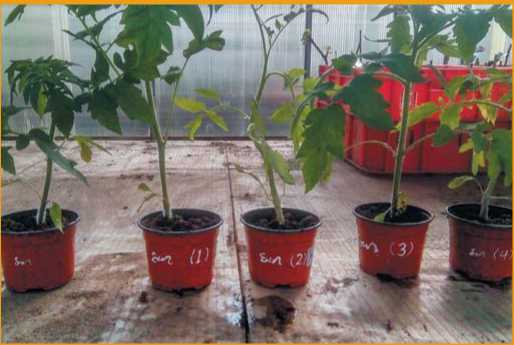
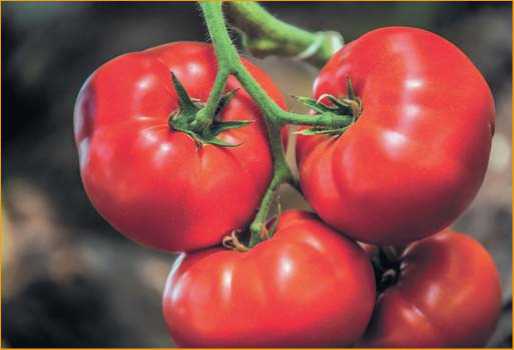
tralize harmful free radicals in the human blood [Debjit Bhowmik K.P., 2012]. In that regard, our research aims improve plant performance, fruit set and yield of tomatoes by studying the effect of plant growth regulators (synthetic and natural) on tomato plants ( Lycopersicon esculentum Mill.), using different new types (Magictone and Hemo bles as growth regulators) on tomato Hybrid “Big Beef F 1 ”.
MATERIALS AND METHODS
This experiment was aimed at studying the effect of spraying with Milagro (1% indol-3-butric acid) and Atlet active substances indol-3-butric acid and chloromequate chloride with applied doses on the vegetative growth, flowering, and fruiting of some tomato varieties. Milagro (1% indol-3-butric acid) and Atlet active substances indol-3-butric acid and chloromequate chloride with applied doses (0.6 M/L, 1.0 M/L and 1.5 M/L) and (1.0, 1.5 and 2.0 M/L) were applied three times on tomato plants (Big Beef F 1 ). All applied doses expressed in terms of active substances. Milagro and Atlet were applied three times with three replications (spraying on plants at 30 DAP, spraying on plants at 60 DAP and 90 DAP). Soaked seeds were planted on trays, then after 30 DAP, tomatoes seedling was transplanted on pots (20-inch diameter). Average day and night temperatures in greenhouses were 25 ° C and 18 ° C this conforms within normal temperature ranges established for greenhouse (Maynard D. and Hochmuth G. 2007). Collecting data: Ten plants from each replicate (3 replicates) were selected to measure the following parameters: Plant height (cm), Number of Leaves per Plant, Leaf Area Index LAI (m2/Plant) and Weight of Fruit (g). LAI was measured by (nondestructive method). Biochemical properties were evaluated in the fruit ripening stage to determine [AOAC 1990] and [Horwitz W., 2006]. The results were analyzed using one-way analysis of variance (ANOVA) followed by Tukey’s HSD test with α = 0.05 with the help of Co-stat program.
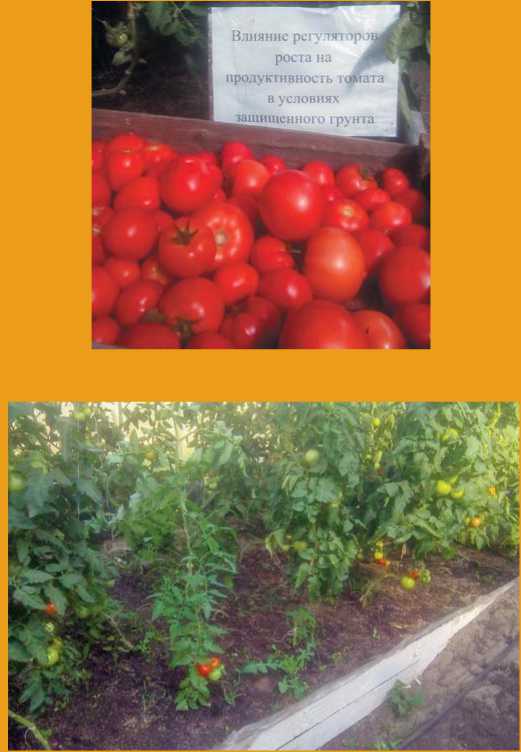
RESULTS AND DISCUSSIONS
Plant height (cm): produced by tomato plant was found to be significantly affected by spraying treatments with Milagro and Atlet in Fig.1.
with Milagro and Atlet (Fig. 3). Results showed that no significant different wear found between Milagro 1.0 M/L of stem diameter value (1.07, 1.5 and 2.03 cm) in the first season at 30 and 90 days after transplanting in the second
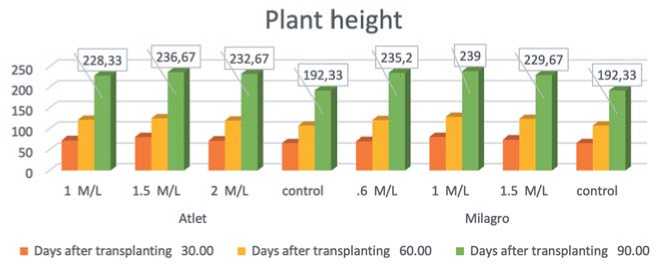
Results showed that spraying plants with Milagro 1.0 M/L showed the highest value of plant height (80.13, 128.77 and 239 cm) at 30, 60 and 90 days after transplanting (DAT) respectively over the three years of study (Fig. 1). Our results agree with [Valdrighi M. et al., 1996] and (Steffy Kamboj.et al., 2017).
Number of leaves: Number of leaves produced by tomato plant was found to be significantly affected by spraying treatments with Milagro and Atlet (Fig. 2). Results showed that spraying with Milagro 1.0 M/L recorded the highest value of number of leaves (18.0, 34.67 and 44.3) at 30 and 60 days after transplanting during the three growing seasons. On the other hand, untreated control recorded the lowest value of number of leaves during the two growing seasons. Our results are consistent with those obtained from [Gabal et al., 1999] the number of leaves in tomatoes increased with the use of plant growth regula- season. On the other hand, untreated control recorded the lowest value of stem diameter during the two growing seasons. Similar results were obtained by Swaroop et al., (2007), Gupta, et al. (2000), Rahul, et al. (2005) and Meena (2008).
Number of clusters: produced by tomato plant was found to be significantly affected by spraying Milagro and Atlet treatments (Fig.4).
Results showed that plants sprayed Milagro 1.0 mg/L produced the highest value of number of cluster (4.67) (16.33) at 30 and 90 days, following 1.5 Mg/L produced the highest value (13.33) at 60 after transplanting in the three seasons. On the other hand, untreated control registered the lowest value during the two growing seasons. It might be due to that agreement with the conclusions of [Akhtar, et al. (1996), Kishan, et al.] and (Steffy Kamboj, et al. 2017).
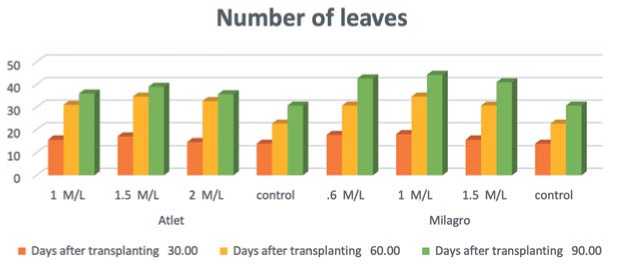
tors, this may be attributed to the fact that plant growth regulators improved cellular nutrition and division with a significant elongation of the stem. The results also corroborate with the results of [Ibrahim et al., 2000; Nielsen S et al., 2003], who reported that the varieties affected the nature of the growth processes.
Stem diameter: The stem diameter of tomato plant was found to be significantly affected by spraying treatments
Leaf Area Index (LAI): Data in fig.5 explain changes in leaf area measurements as a response of the application of different growth regulators to tomato plants at various times.
At 90 DAP, applying Milagro and Atlet increased LAI comparing to control, except (Milagro 1.0 M/L) which was significant. The maximum area (176.4, 213.0 and 210.0 cm2) were obtained from Milagro 1.0 M/L, while the mini-
Stem diameter
Список литературы Effect of indol-3-butric acid and chloromequate chloride on the vegetable and fruit growth of tomato plants
- AOAC 1990. Official methods of analysis the 15th edition. Association of Official Analytical Chemists, Washington DC
- Chin J Anal Chem, Determination of Plant Growth Regulators in Vegetable by High-Performance Liquid Chromatography-Tandem Mass Spectrometry Coupled with Isotop-coded Derivatization, 2015;43(3):419-423.
- Debjit Bhowmik K. P., Sampath K., Shravan P., Shweta S. Tomato-A Natural Medicine and Its Health Benefits. Journal of Pharmacognosy and Phytochemistry. 2012;1(1):33.
- FAO 2017 http://www.fao.org/faostat/en/#data/QC 14/07/2017, 22:31.
- Gabal G.M., Oben G., Garcell R. Effect of GA on morph physiological characters and yield of kidney beans (Phaseiolus valgaris). J. Agron. Sci. 1999;160(2):91-101.
- Gupta, P.K. and Gupta, A.K. Efficacy of plant growth regulators (IAA and NAA) and micronutrient mixtures on growth, flowering, fruiting and shelf life of tomato (Lycopersicon esculentum, Mill.). Bioved Research Society Bioved. 2000;11:1/2,25-29.
- Horwitz, W. (Ed). 2006. Official Methods of Analysis. 18th E
- Ibrahim K., Amans A., Abubakar I.U. Growth indices and yield of Tomato (Lycopesicon esculentum karest) varieties as influenced by crop spacing at samaru. Proceedings of the 18th HORTSON Conference. 2000;1:40-47.
- Kader A.A. Flavor quality of fruits and vegetables. Journal of the Science of Food and Agriculture. 2008;88:1863-1868.
- Kaloo, G. Tomato (lycopresicon esculentum). Allied publishers Pvt. ltd., New Delhi, 1986. P.203-220.
- Ministry of Agriculture of the Russian Federation. Handbook of pesticides and agrochemicals, allowed for application in the territory of the Russian federation, Moscow, 2015. 1-735 (translated from Russian).
- Nielsen S. Food analysis (3rd ed.). New York: Kluwer Academic. 2003.
- Rahman M., Nahar M.A., Sahariar M.S., Karim M.R. Plant growth regulators promote growth and yield of summer tomato. Progressive Agriculture. 2015;26:32-37.
- Santner, A., Calderon-Villalobos, L.I.A., Estelle, M. Plant hormones are versatile chemical regulators of plant growth. Nat. Chem. Biol. 2009;5(5):301-307.
- Sandeep Kumar Singh, Nidhika Thakur and Yamini Sharma. Plant growth regulators in fruit and vegetable crops. International Journal of Agricultural Sciences. 2013;9(1):433-437.
- Steffy Kamboj, Karampal Singh, Snehdeep Singh, Navdeep Gandhi. Department of Agriculture, D.A.V. College, Abohar (India). Effect of Indole Butyric Acid on Rooting and Vegetative Parameters of Pomegranate (Punica granatum L.) Cuttings. International journal of advance research in science. 2017;06(01).
- Taylor J.H. 1987. Text of lectures delivered at the national workshop on fruit and vegetable seedlings production held at NIHORT 9-13.
- Valdrighi M.M., Pera A., Agnolucci M., Frassinetti S. Effects of compost-derived humic acids on vegetable biomass production and microbial growth within a plant (Cichorium intybus) soil system: a comparative study. Agric. Eco. and Envir. 1996;58:133-144.

